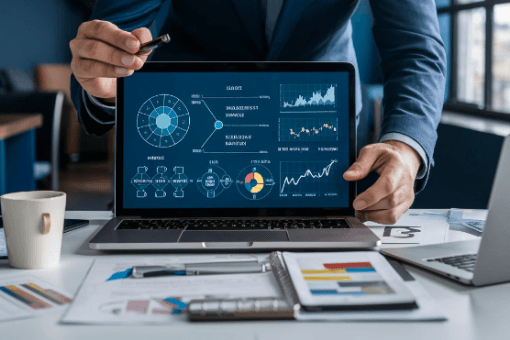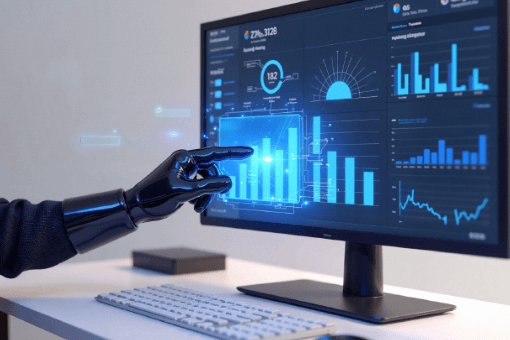Introduction
Data analytics has become the backbone of modern decision-making processes across industries. Businesses rely on data-driven insights to optimize operations, understand customer behavior, and gain a competitive edge. However, choosing the best software for data analytics is crucial for effectively processing, visualizing, and interpreting large volumes of structured and unstructured data analytics.
In this blog, we’ll explore the best data analytics tools available in 2025 and help you make an informed decision for your organization.
Table of Contents
Why Data Analytics Software is Essential for Businesses
Data analytics software enables businesses to:

- Identify patterns and trends in complex data sets.
- Improve decision-making through actionable insights.
- Optimize operational efficiency and customer experiences.
- Stay competitive by predicting market changes.
Whether you’re a small business or a large enterprise, having the right tools to manage and analyze your data can significantly impact your success.
Key Features to Look for in Data Analytics Software

When selecting a data analytics tool, consider the following key features:
- Data Integration: The ability to connect with various data sources.
- Data Visualization: Tools for creating interactive and easy-to-understand dashboards.
- Scalability: Support for handling growing volumes of data.
- Advanced Analytics: Features like machine learning and predictive analytics.
User-Friendly Interface: Intuitive design for both technical and non-technical users.
Best Software for Data Analytics in 2025

1. Tableau
Tableau is a leader in data visualization and analytics. Its intuitive drag-and-drop interface makes it easy to create interactive dashboards.
- Key Features: Data blending, real-time collaboration, and integration with various data sources.
- Best For: Organizations that prioritize visual storytelling with their data.
2. Power BI
Microsoft Power BI offers robust analytics and reporting capabilities.
- Key Features: Seamless integration with Microsoft products, AI-driven insights, and customizable dashboards.
- Best For: Businesses using Microsoft’s ecosystem looking for an affordable analytics solution.
3. Google Data Studio
Google Data Studio is a free tool that helps users create interactive dashboards.
- Key Features: Integration with Google products, easy sharing, and customizable templates.
- Best For: Startups and small businesses seeking a budget-friendly solution.
4. SAS
SAS is a pioneer in advanced analytics and has been a trusted name for years.
- Key Features: Machine learning, predictive analytics, and robust data management.
- Best For: Enterprises needing advanced statistical modeling.
5. Apache Spark
Apache Spark is an open-source analytics engine known for big data processing.
- Key Features: Real-time data processing, machine learning libraries, and compatibility with Hadoop.
- Best For: Companies dealing with massive data sets and requiring fast processing.
6. IBM Cognos Analytics
IBM Cognos Analytics offers AI-driven insights and comprehensive reporting tools.
- Key Features: Natural language query capabilities, advanced analytics, and dynamic dashboards.
- Best For: Large enterprises needing sophisticated reporting and AI-powered analytics.
7. Qlik Sense
Qlik Sense provides self-service analytics and data visualization.
- Key Features: Associative data model, AI capabilities, and cloud-based deployment.
- Best For: Organizations seeking flexibility and powerful data discovery tools.
Comparison of Top Data Analytics Tools
| Software | Best For | Key Strength | Pricing |
| Tableau | Data Visualization | Interactive Dashboards | Premium Pricing |
| Power BI | Microsoft Users | Seamless Integration | Affordable |
| Google Looker Studio | Budget-Conscious Users | Free & User-Friendly | Free |
| SAS | Advanced Analytics | Statistical Modeling | Enterprise Pricing |
| Apache Spark | Big Data Processing | Real-Time Analytics | Open Source |
| IBM Cognos Analytics | AI-Driven Insights | Natural Language Query | Enterprise Pricing |
| Qlik Sense | Data Discovery | Associative Data Model | Mid-Range Pricing |
Choosing the Right Data Analytics Software for Your Needs
Here are some tips to help you choose the best software for data analytics:
- Assess Your Business Needs: Determine the complexity and scale of your data analytics requirements.
- Consider Budget Constraints: Factor in the cost of licensing, implementation, and maintenance.
- Evaluate User Skills: Choose a tool that aligns with the technical capabilities of your team.
- Test Compatibility: Ensure the software integrates with your existing systems.
- Leverage Free Trials: Test different tools before making a final decision.
For those looking to deepen their understanding of analytics, there are excellent books for data analytics and several best data analytics bootcamps that offer hands-on training.
Cloud-Based Analytics and Consulting
As businesses increasingly migrate to cloud-based data analytics, flexibility and scalability have become critical. Engaging with data analytics consulting firms can further help implement the right strategies tailored to your business needs.
Conclusion
Selecting the best software for data analytics is crucial for harnessing the power of data in your organization. Whether you prioritize visualization, advanced analytics, or budget-friendly options, the tools mentioned in this blog offer diverse solutions for different business needs. Cloud-based data analytics tools are particularly gaining popularity for their scalability and flexibility.
Additionally, consider seeking advice from data analytics consulting firms to guide you in implementing the right solution for your business. By understanding your specific requirements and exploring the features of these top tools, you can make a data-driven decision that empowers your business to thrive in a competitive landscape.













